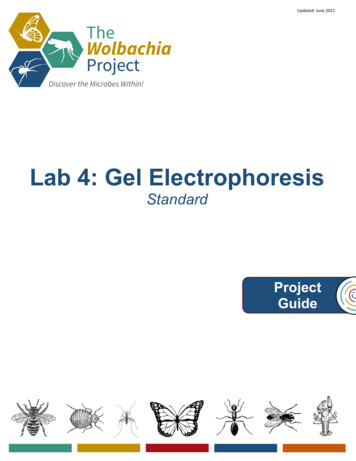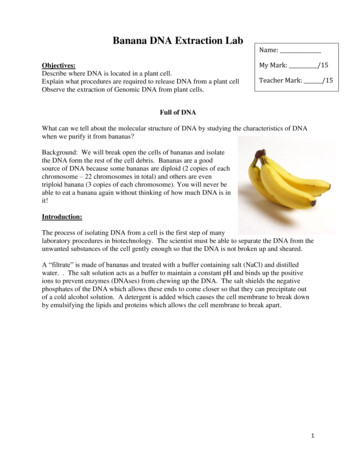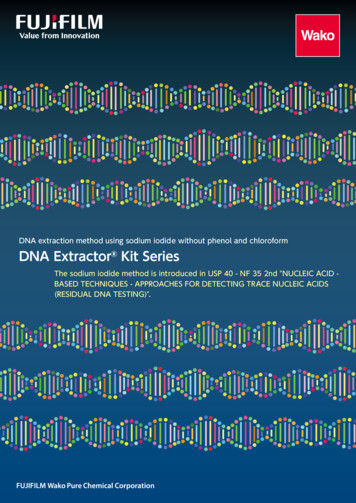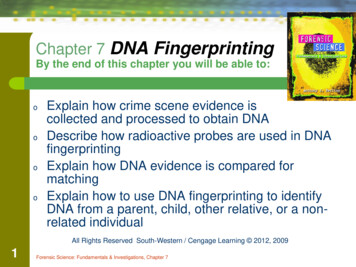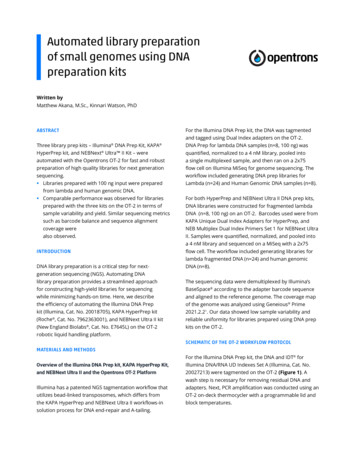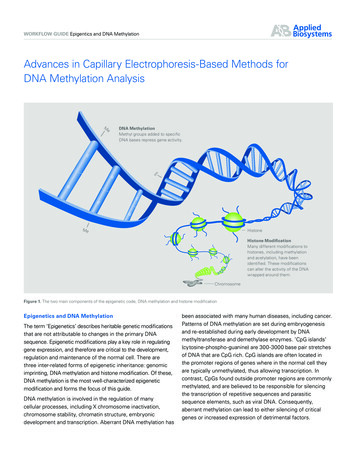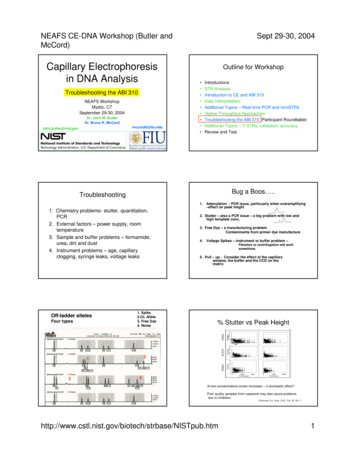
Transcription
NEAFS CE-DNA Workshop (Butler andMcCord)Capillary Electrophoresisin DNA AnalysisTroubleshooting the ABI 310NEAFS WorkshopMystic, CTSeptember 29-30, 2004Dr. John M. ButlerDr. Bruce R. McCordmccordb@fiu.edujohn.butler@nist.govSept 29-30, 2004Outline for Workshop IntroductionsSTR AnalysisIntroduction to CE and ABI 310Data InterpretationAdditional Topics – Real-time PCR and miniSTRsHigher Throughput ApproachesTroubleshooting the ABI 310 (Participant Roundtable)Additional Topics – Y-STRs, validation, accuracyReview and TestBug a Boos .Troubleshooting1. Chemistry problems- stutter, quantitation,PCR2. External factors – power supply, roomtemperature3. Sample and buffer problems – formamide,urea, dirt and dust4. Instrument problems – age, capillaryclogging, syringe leaks, voltage leaksOff-ladder allelesFour types1. Spike2.OL Allele3. Free Dye4. Noise2. Stutter – also a PCR issue – a big problem with low andhigh template conc.3. Free Dye – a manufacturing problemContaminants from primer dye manufacture4. Voltage Spikes – instrument or buffer problem –Filtration or centrifugation will worksometimes5. Pull – up - Consider the effect of the capillarywindow, the buffer and the CCD on thematrix% Stutter vs Peak Height2131. Adenylation - PCR issue, particuarly when overamplifying–effect on peak height4At low concentrations stutter increases – a stochaistic effect?Poor quality samples from casework may also cause problemsdue to e/NISTpub.htm1
NEAFS CE-DNA Workshop (Butler andMcCord)Sept 29-30, 2004Overloaded peaks will also showrelatively high stutterTemperature effects Viscosity – mobility shift– µep q/6πηr Diffusion – band broadening–DNA Conformation – DNA size based sieving–Truncated peaks give wrong ratios for peak stutterWhy else is overlaoding bad?1. raised baseline2. non specific amplification3. peak hight ratiosBand shift in CE Analysis of the FGA locusLikely the result of temperature or viscosity inducedmobility change vs ----- µep q/6πηr Current – PowerP VI I2R–Effect of Temperature on allele sizeFGA Allele eSlope is 0.14 bases/degree centigradeStandard deviation is O. 17 or soTherefore a small change in temperature has a big effectWhat to do if calibration is lost?Due to its structure and its non-calibration,the “250”peak can be used to indicate stability If protocol permits––––Go to the next ladderRerun sampleCheck currentCheck allelic ladder Always check the Rox ladderInitial RunStability losses toTemperatureElectroosmosisSyringe leaksAdsorptionExcess currentBlockages– Look for extra bands– Check peak height– Check parameters and NISTpub.htm2
NEAFS CE-DNA Workshop (Butler andMcCord)Sept 29-30, 2004Monitoring Room Temperature Over TimeCleanliness Urea sublimates and breaks down to ioniccomponents - these find a path to ground Similarly wet buffer under a vial creates pathsto ground Capillary windows must be clear or matrixeffects will occur Laser will often assist in this process Vial caps will transfer low levels of DNA tocapillary 10 oC spread(over many weeks)Storage when ABI 310 is not in useCarbon Trails Keep inlet of capillary inwater if it dries out thenurea crystals from thepolymer will clog the opening The waste vial (normally inposition 3) can be movedinto positionHigh Humidityor wet buffer vialscan create otherpaths to ground A special device can bepurchased from Suppelco torinse the capillary off-line Store in distilled waterRemember that the water in the opentube will evaporate over time Note that the laser is onwhen the instrument is onKeep Your System Clean!Consider the optical systemLaser(488nm)The Detection WindowMake sure that the capillarywindow is lined up (if it is not,then no peaks will be seen)λDetection WindowCharged coupleddeviceLaserCapillaryCCDOpticsWindow may need to be cleanedwith ethanol or methanolReview Start of Raw Data /biotech/strbase/NISTpub.htmLittle spikes indicate need tochange buffer check current3
NEAFS CE-DNA Workshop (Butler andMcCord)Sept 29-30, 2004Buffer IssuesRaised Baseline Problem A poor matrix can lead to raised baseline andtherefore calling of too many peaks Larger sized alleles will not be identified as peaksbecause the GeneScan table for a particular dyecolor has filled up The buffer and polymer affect the backgroundfluorescence- affecting the matrix Urea crystals and dust may produce spikes High salt concentrations may producereannealing of DNA High salt concentrations affect current Low polymer concentrations affect peakresolutionCapillary Resolution DifferencesSome Other Problems(A) Good resolution Capillary with poor resolution “Melt downs” – sample contaminants Syringe leak or bottoming – peak broadeningand mobility shifts Formamide conductivity gives low sensitivityor excessive sensitivity6FAM(blue)D8S1179D21S11(B) Poor resolutionD7S820Identifiler dataCSF1POTH01VIC(green)D13S317 (red)VWAD5S818D18S51FGAGS500 LIZ size 100ArrayArrayButler, J.M., Buel, E., Crivellente, F., McCord, B.R. (2004) Forensic DNA typing by capillary electrophoresis:using the ABI Prism 310 and 3100 Genetic Analyzers for STR analysis. Electrophoresis, 25: 1397-1412.Meltdowns can be permanent or transitoryDoes the capillary need to be replaced?No! The next injection looks fine A permanent loss of resolution may mean Adsorptive sites on a capillaryInitiation of electroosmotic flowConductivity changes in bufferWrong molecular weight or concentration ofsieving polymer e/NISTpub.htm4
NEAFS CE-DNA Workshop (Butler andMcCord)Sept 29-30, 2004Transition metal ionsCE: Effect of pH 7 vs. 8.3Metal cations present in degraded samples representa different type of contaminationNi-counterion TH01 (pH 7)A proposed schematicfor Zn-DNA1Ni-intercalated TH01 (pH 8.3)Zn2 , Co2 , and Ni2 form DNA-metal ion complexes, termedM-DNA.at pH conditions above 8,These cations produce severe effects in CE injectionand analysisHartzell and McCord,in Lett.press2001, 86, 3670-3673.1) Rakitin,Electrophoresis,A. et al. Phys. Rev.Another cause of band broadening can bepoor capillary loading1 µl TH01 added to 10 µl of 3.0 mM NiCl2 in 10 mM Tris, pH 7 or pH 8.3. Sample allowedto interact for 1 hr and then 1 µl added to ROX/formamide.Remove all bubbles from the channels Syringe leaks– At the barrel– At the capillary nut– At the capillary window Viscosity changes– Water in the block– Bubbles– Temperature Capillary conditioning– Preelectrophoresis– cloggingBubbles in the channels can prevent flow ofions and are usually exhibited by zero currentwhen the voltage is appliedBeware of Urea CrystalsUrea crystals haveformed due to a smallleak where the capillarycomes into the pumpblockPump block should be well cleaned to avoidproblems with urea crystal formationTroubleshooting is more than followingthe protocolsIt means keeping watch on all aspects of theoperation1. Monitoring conductivity of sample andformamide2. Keeping track of current and syringeposition in log.3. Watching the laser current4. Watching and listening for voltage spikes5. Monitoring room temperature and ISTpub.htm5
NEAFS CE-DNA Workshop (Butler andMcCord)Sept 29-30, 2004Roundtable of WorkshopParticipants’ Problem STpub.htm6
Storage when ABI 310 is not in use Keep inlet of capillary in water if it dries out then urea crystals from the polymer will clog the opening The waste vial (normally in position 3) can be moved into position A special device can be purchased from Suppelco to rinse the capillary off-line Store in distilled water Note that the laser is on when the instrument is on Remember .


